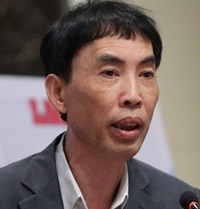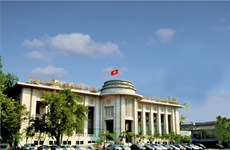Regional partnership to benefit Vietnam, ASEAN
 Vo Tri Thanh, deputy director of the Central Institute for Economic Management (CIEM) (Source: VNS/VNA)
Vo Tri Thanh, deputy director of the Central Institute for Economic Management (CIEM) (Source: VNS/VNA)Vo Tri Thanh, deputy director of the Central Institute for Economic Management (CIEM), spoke to the media about the RCEP's likely impacts.
Question: What will be the impact of the Regional Comprehensive Economic Partnership on Vietnam's economy?
Vo Tri Thanh: It could be said this is a necessary pact in the development process of the Association of Southeast Asian Nations (ASEAN), ASEAN+1 and ASEAN+6. We are just able to provide initial impacts of the pact to the economy as it would depend much on negotiation process as well as its commitment level. However, the initial findings show that the RCEP would bring good opportunities to the country.
Firstly, Vietnam will have a chance to access a huge market of 3.4 billion people with a combined GDP of 21 trillion USD, accounting for 29 percent of the world's gross domestic product (GDP). Like the Trans-Pacific Partnership (TPP), the RCEP signatory countries have a rapidly growing middle class.
Secondly, the RCEP aims to link ASEAN with six countries – Australia, China, India, Japan, the Republic of Korea, and New Zealand – which have developing production network.
Thirdly, the ASEAN has a deep association not only inside its big scale market but also major global partners like the EU and the US. The pact will bring many opportunities to Vietnam in terms of access to new markets and tariffs to export to developed countries. The strong associated market will attract investors both within the region and in the EU and the US. Sectors like fisheries, agriculture, construction, garments and textiles, and leather footwear will have additional opportunities for growth.
Besides [trade] liberalisation, the pact also discusses co-operation and development. This is the reason why the RCEP is not just a story about free trade but also about cooperation among parties, including some less developed countries.
However, the pact will also bring challenges to Vietnam. Several countries joining the RCEP have goods and trade structures that compete with Vietnam's. With further integration, Vietnam will have to face the competition.
The agreement also focuses much on reforms since foreign investors will see the region as a relatively integrated market. They will choose countries that are more attractive. It requires greater efforts from Vietnam to reform itself to attract foreign investors.
Another challenge for Vietnam will be the low competitiveness of some sectors and lack of participation in the global production chain.
Q: One of the challenges for Vietnam is competition. It is clear that Vietnamese goods will have to compete with imported products. People are also worried about competition between domestically produced items. What are your comments about this?
A: Firstly, I have to say that the nature of free trade pacts is to follow market economy rules or competition. That is the reason why we should view competition positively. Competition could bring benefits to customers, enable effective distribution of resources as well as create momentum for improving products and using more technology. Overall, competition is good. In the process of integration, some products that cannot compete with others will see reduced production. It is normal. The issue is how the products will be supported by the Government to shift to other sectors with minimum losses and costs. The support relates to training and providing information and time for the change. There is no play in which all will be winners. If we accept the market economy mechanism, we have to cope with competition and try to maximise the impacts.
Q: Will the situation result in unhealthy competition?
A: We often make the mistake that unhealthy competition is due to the market economy. The main reason for the unhealthy competition is lack of information. For example, monopolies are caused by the lack of markets.
The issue is how to monitor and have tough penalties. In free trade pacts, the issues of oversight, dispute resolution and transparency are highly valued. These could help make competition healthier.
Q: Is there an overlap between the RCEP and TPP?
A: The RCEP and TPP will not clash but support each other to help Vietnam integrate further into the global economy.
RCEP is a free trade agreement between the ASEAN bloc and six other partners: China, Japan, the RoK, Australia, New Zealand, and India. ASEAN is the main force in RCEP with strong support from China while the US is not in the pact.
The TPP includes 12 nations on either side of the Pacific ocean – Australia, Brunei, Canada, Chile, Japan, Malaysia, Mexico, New Zealand, Peru, Singapore, the US, and Vietnam. The US is the main player in the TPP while China, the world's second largest economy, is not part of the pact.
The two pacts have a similar scale since the TPP accounts for 40 percent of world GDP and 26 percent of trade while for the RCEP it is 29 percent and 28 percent.
The two pacts have a common feature, namely commitment to free trade in goods and services and to investment. In the RCEP, ASEAN is looking for cooperation and equal development. The TPP is a free trade agreement aimed at resolving the issues of labour standards, a competitive environment, State-owned enterprises, State purchases, and intellectual property.-VNA













